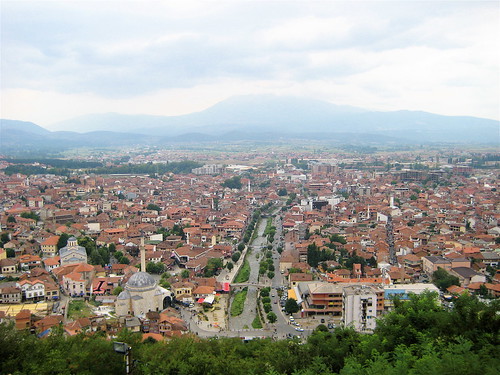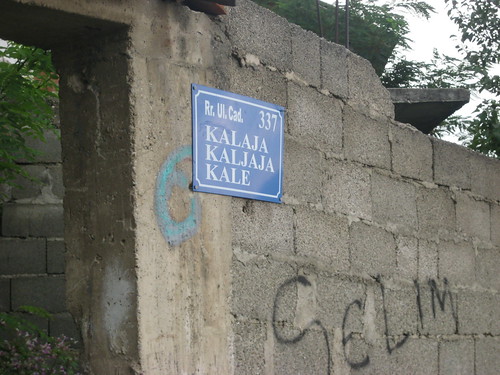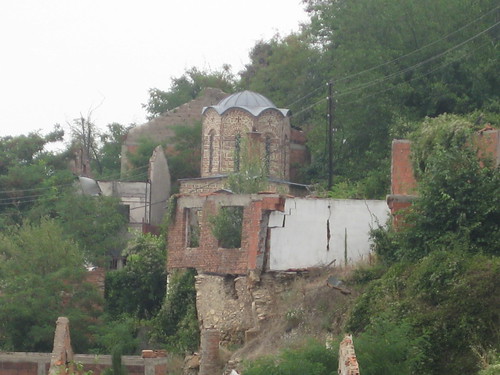
Kaljaja (Каљаја) or Prizren Fortress
Kaljaja is the medieval fortress in Prizren dating from 11th century, in which once the capital of Serbian Empire was located. It was built on a hill above the Bistrica River, around which the modern city developed. The first fort, erected on this location by the Byzantines, was further expanded by Tsar Stefan Uroš IV Dušan of Serbia. The fort then came under the Ottomans, who controlled it for four and a half centuries, giving it its modern shape.

The fort is now in ruins, but still can be see its monumentality, although it is difficult to discern the outlines of the original medieval town and the number of Towers due to later expansion.

It's sure worth to climb up the Podkaljaja quarter to reach the fortress as it pays back with a wonderful panoramic view of the city of Prizren, the Bistrica Valley and the surroundings.
Podkaljaja the eyesore of Prizren

As beatuful and charming the city of Prizren might be...there is however a black sopt that disturbs the eye of the tourist: the former Serbian district of Podkaljaja.

In March 17th of 2004 some rioting albanian terrorist destroyed and devastated the serbian district of Podkaljaja (lit. the district under the Kaljaja). Moderate Albanian leader condemmend the actions of those extremistes.

What you see in these pictures happened in "peace" time when KFOR was controlling the territory.
Saint Saviour Church (Sveti Spas)

Walking up to the fortress you walk by a Churche controlled by German KFOR and warning signs everywhere.
The endowment of landowner Mladen Vladojevic with his parents, at the time of Tsar Dusan's rule, was built around 1330 and in 1348 given as a gift to the nearby monastery of Holy Archangels. The Vlach community in Prizren, which had the right to use this little church from the second half of the 18th century, built, in 1836, high walls of a future shrine which was never completed and the church of St. Spasa thus became only a part of its northern nave.
The medieval church is of small dimensions, with the foundation in the shape of the shortened cross with octangular dome and the apse three-sided from outside. It was decoratively built with neat alternate layers of limestone and brick and with ceramoplastic ornaments.

The paintings were painted in two phases: firstly in the altar around 1335 and the paintings are of poorer quality and then in the rest of the church until 1348 when a part of the altar area was repainted. The original paintings on the altar were painted by one painter, a member of the workshop which also painted the church of St. Nikola, endowment of Dragoslav Tutic. Small dimensioned frescoes from the second phase were painted by local painters educated by the good traditions of the Byzantine art who had a sure and prominent drawing. A third painter painted Christ and the Virgin Paraklisa in priprata most probably after 1348. The paintings were greatly damaged and a fire in the 19th century changed their palette.
Conservation works on architecture and frescoes were carried out in the 1953-1963 period.
After the Kosovo war 1998-1999 St. Savior church is under constant guard by German KFOR troops. It's not possible for now to visit the ruins.






























 Entering the old city center
Entering the old city center
 The old town is a lively place full with pleasant places and enough green spots.
The old town is a lively place full with pleasant places and enough green spots.





 The old town is pedestrian zone and has many cozy places under the shades of big trees to dwell and and enjoy a drink!
The old town is pedestrian zone and has many cozy places under the shades of big trees to dwell and and enjoy a drink! Also in the evening the city is busy and busting. Below you'll find some useful link if you plan to visit this charming city:
Also in the evening the city is busy and busting. Below you'll find some useful link if you plan to visit this charming city: